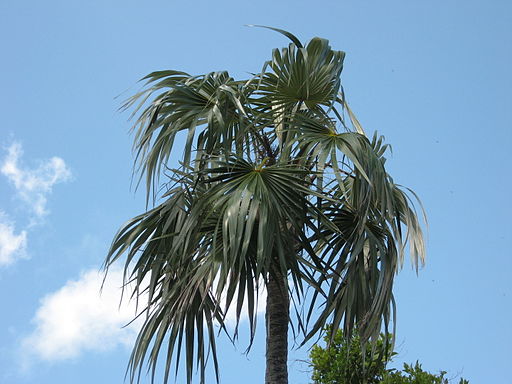Classification System: APG IV
Superregnum: Eukaryota
Regnum: Plantae
Cladus: Angiosperms
Cladus: Monocots
Cladus: Commelinids
Ordo: Arecales
Familia: Arecaceae
Subfamilia: Coryphoideae
Tribus: Cryosophileae
Genus: Coccothrinax
Species: Coccothrinax argentata
Name
Coccothrinax argentata (Jacq.) L.H.Bailey, Gentes Herb. 4: 223, t. 140-143 (1939)
Synonyms
Basionym
Palma argentata Jacq., Fragm. Bot.: 38 (1803).
Heterotypic
Thrinax garberi Chapm., Bot. Gaz. 3: 12 (1878).
Coccothrinax garberi (Chapm.) Sarg., Bot. Gaz. 27: 90 (1899).
Coccothrinax jucunda Sarg., Bot. Gaz. 27: 89 (1899).
Coccothrinax jucunda var. macrosperma Becc., Webbia 2: 312 (1907).
Coccothrinax jucunda var. marquesensis Becc., Webbia 2: 313 (1907).
Thrinax altissima N.Taylor in L.H.Bailey, Stand. Cycl. Hort. 6: 3334 (1917).
Distribution
Native distribution areas:
Continental: Southern America
Bahamas, Colombia, Southwest Caribbean, Turks-Caicos Is.
Continental: Northern America
Florida
References: Brummitt, R.K. 2001. TDWG – World Geographical Scheme for Recording Plant Distributions, 2nd Edition
References
Bailey, L.H. 1939. Coccothrinax of Florida. Gentes Herbarum 4: 220–225.
Links
Govaerts, R. et al. 2018. Coccothrinax argentata in Kew Science Plants of the World online. The Board of Trustees of the Royal Botanic Gardens, Kew. Published online. Accessed: 2018 Dec. 16. Reference page.
International Plant Names Index. 2018. Coccothrinax argentata. Published online. Accessed: Dec. 16 2018.
The Plant List 2013. Coccothrinax argentata in The Plant List Version 1.1. Published online. Accessed: 2018 Dec. 16.
Tropicos.org 2018. Coccothrinax argentata. Missouri Botanical Garden. Published online. Accessed: 16 Dec. 2018.
USDA, ARS, Germplasm Resources Information Network. Coccothrinax argentata in the Germplasm Resources Information Network (GRIN), U.S. Department of Agriculture Agricultural Research Service. Accessed: 08-Apr-12.
Vernacular names
English: Florida silver palm
Coccothrinax argentata, commonly called the Florida silver palm,[3] is a species of palm tree. It is native to south Florida, southeast Mexico, Colombia and to the West Indies, where it is found in the Bahamas, the southwest Caribbean and the Turks and Caicos Islands. Its natural habitat is rocky, calcareous soil in coastal scrubland and hammock communities.
Description
It is a small (2–6 m tall), slow-growing fan palm with leaves that are dark blue-green above and silver-coloured below.[4] Measurements in Fairchild Tropical Garden showed an average growth rate of 12 centimetres (4.7 in) per year.[5] Flowers are white and small on light orange branches. The fruits are globose and half an inch in diameter. They are initially green and turn purple or black when ripe.
Silver palms in their natural habitat often grow among saw palmetto (Serenoa repens) and cabbage palmetto (Sabal palmetto) which have similar fronds. Silver Palms can be distinguished by its smooth vertical trunk, and its small, crescent-shaped hastula.[6]
Coccothrinax argentata can be successfully grown in lawns and gardens
Taxonomy
Coccothrinax argentata was first described in 1803 by Nikolaus Joseph von Jacquin as Palma argentata. It was transferred to the genus Coccothrinax by Liberty Hyde Bailey in 1939.[2]
Distribution and habitat
Coccothrinax argentata is native to Florida in the southeastern United States, southeast Mexico, Colombia, and parts of the Caribbean, where it is found in the Bahamas, the southwest Caribbean, including the Colombian Caribbean islands,[7] and the Turks and Caicos Islands.[2][8] Its natural habitat is rocky, calcareous soil, including coastal scrubland and hammock communities.[6]
Populations on the Atlantic Coastal Ridge in Southern Florida are now recognized as Coccothrinax argentata garberi. This subspecies can be distinguished from Coccothrinax argentata argentata by shorter petioles and reduced stature.[9][10]
Bahia Honda State Park in the Florida Keys has one of the largest stands of silver palms in the United States.[11] They can be found on a nature walk just off of Sandspur Beach.
Ecology
The endangered Florida Key Deer are known to feed on the fruits of the silver palm.
References
Carrero, C. (2021). "Coccothrinax argentata". IUCN Red List of Threatened Species. 2021: e.T67534749A67534752. doi:10.2305/IUCN.UK.2021-1.RLTS.T67534749A67534752.en. Retrieved 18 November 2021.
"Coccothrinax argentata". World Checklist of Selected Plant Families. Royal Botanic Gardens, Kew. Retrieved 2019-02-25.
USDA, NRCS (n.d.). "Coccothrinax argentata". The PLANTS Database (plants.usda.gov). Greensboro, North Carolina: National Plant Data Team. Retrieved 13 January 2017.
Gilman, Edward F.; Dennis G. Watson (November 1993). "Coccothrinax argentata Silverpalm" (PDF). USDA Forest Service Fact Sheet ST-176. Retrieved 2010-10-08.
Zona, Scott; Maidman, Katherine (September 2001). "Growth rates of palms in Fairchild Tropical Garden". Palms. 45 (3): 151–154.
Flora of North America
Henderson, Andrew; Galeano, Gloria; Bernal, Rodrigo (1995). Field Guide to the Palms of the Americas. Princeton, New Jersey: Princeton University Press. ISBN 0-691-08537-4.
Wunderlin, Richard P.; Bruce F. Hansen (2003). Guide to the Vascular Plants of Florida (Second ed.). Gainesville: University Press of Florida. ISBN 0-8130-2632-6.
Atlas of Florida Plants
Zona, Scott; Hass, Michael (April 2018). "Mainland and Island Populations of Coccothrinax argentata (Arecaceae): Revisiting a Common Garden Experiment in its 18th Year". Systematic Botany. 43 (1): 153–161.
Bahia Honda State Park, brochure
Retrieved from "http://en.wikipedia.org/"
All text is available under the terms of the GNU Free Documentation License


